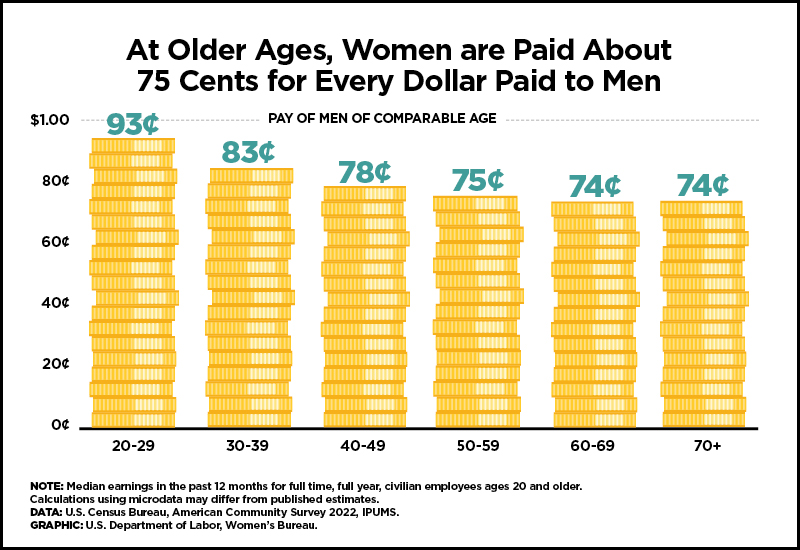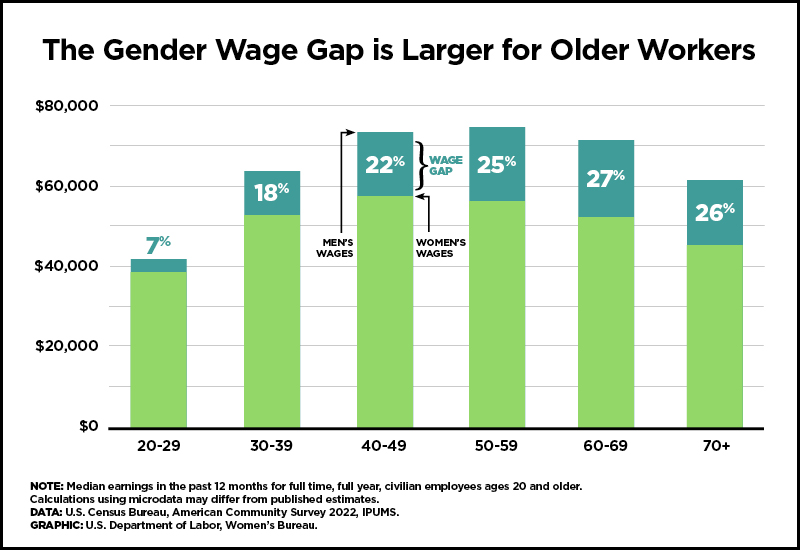" 
Older women are losing out
President Biden recently identified older workers as the “Backbone of the Nation.”
While that may be the case, older women workers – who comprise 47% of the labor force ages 55 and older – are plagued by a gender wage gap that is even larger than the one their younger counterparts experience.
Among workers ages 50 or older, women working full-time and year-round are paid about 75 cents for each dollar their male counterparts make.
In 2022, the most recent year for which data are available, women 50-59 working full-time, year-round were paid about $56,000 annually – $18,300 less than their male counterparts. Women 60-69 were paid about $18,800 less than men in their 60s and women 70 or older were paid about $16,000 less than men in their 70s. To put this in perspective, among people ages 20-29, women were paid a median of $39,200 and men a median of $42,100 – an annual difference of about $3,000.

These annual wage losses add up. Estimates suggest that over the course of their careers, women lose an average of nearly $400,000relative to white non-Hispanic men due to gender and racial wage gaps. Hispanic and Native American and Pacific Islander women make $1 million less than white non-Hispanic men, while Black women make nearly $900,000 less. These earnings deficits mean less purchasing power for women and their families and less financial security for older women (65+), 11.2% of whom live in poverty. In addition, lower wages can impact Social Security benefits and other sources of retirement income such as IRAs and 401(k)s.
Research from the Women’s Bureau and the U.S. Census Bureau shows that 70% of the gender pay gap remains unexplained after adjusting for gender differences in education, occupation, industry, work experience, hours worked and other worker characteristics. This remaining unexplained wage gap is due to a combination of unobservable worker characteristics and discrimination.
Solutions
Salary history bans are one solution that can help alleviate pay disparities. The federal government now bans the use of non-federal salary history to determine wages for federal employees, and the Biden-Harris Administration has proposed a similar rule for federal contractors.
Given the outsized role that occupational segregation plays in the gender wage gap, programs that provide pathways for women into high-paying nontraditional occupations, such as the Women’s Bureau’s Women in Apprenticeship and Nontraditional Occupations (WANTO) grant program, can help reduce pay disparities and increase economic security.
Furthermore, eliminating discrimination is key to closing gender wage gaps. The federal government is playing a role: Since Fiscal Year 2022, the Department of Labor’s Office of Federal Contract Compliance Programs, the Equal Employment Opportunity Commission and the Department of Justice have collectively recovered over $20 million in monetary relief for women who have experienced pay discrimination in the workplace.
Older Workers and Gender Pay


